Modeling the Impact of Liquid Polymers on Concrete Stability in Terms of a Slump and Compressive Strength
Abstract
1. Introduction
Research Significance
2. Materials and Methods
2.1. Ordinary Portland Cement
2.2. Aggregate
2.3. Additives
2.4. Slump
2.5. Compressive Strength
2.6. Concrete Mix
2.7. Modelling
2.7.1. Nonlinear Regression Model
2.7.2. M5P Model
2.8. Performance Evaluation and Model Criteria
3. Results and Analysis
3.1. Water-Reducing Additives
3.2. Slump Retention (ASTM C 143-90)
3.3. Compressive Strength
3.4. Predicted and Measured Compressive Strength Relationships
3.4.1. The Nonlinear Regression Model (NLR)
3.4.2. M5P-Tree Model
4. Conclusions
- The compression strength of cement increased from 84% to 250%, depending on the mix proportion. Based on NLR parameters, polymer RC897 had the highest impact on increasing the compression strength of concrete as compared to polymer SP62 and PC180. This improvement in compression strength was due to the dispersion of cement particles and increasing the friction between the particles, reducing the void ratio and increasing the density of concrete.
- With a cement content of 300 kg, the polymer PC180 had the highest effect on reducing the water content of the other two types of the polymer by 43.5%, while, at a cement content of 400 kg, the polymer RC 897 had the highest effect on reduction in water content compared with the other two polymers, by 46.7%.
- The compressive strength of the concrete mixes was calculated using NLR and M5P-tree models. The correlation of the coefficient (R2) and the root mean square error (RMSE) are used as assessment criteria. The order of the models was M5P-tree and NLR; the M5P-tree was the best model offered in this study, based on data obtained from the experimental work, and provided a higher R2 and a lower MAE and RMSE.
Author Contributions
Funding
Conflicts of Interest
References
- Fu, T.C.; Yeih, W.; Chang, J.J.; Huang, R. The influence of aggregate size and binder material on the properties of pervious concrete. Adv. Mater. Sci. Eng. 2014, 2014, 963971. [Google Scholar] [CrossRef]
- Burhan, L.; Ghafor, K.; Mohammed, A. Modeling the effect of silica fume on the compressive, tensile strengths and durability of NSC and HSC in various strength ranges. J. Build. Rehabil. 2019, 4, 19. [Google Scholar] [CrossRef]
- Mohammed, A.; Burhan, L.; Ghafor, K.; Sarwar, W.; Mahmood, W. Artificial neural network (ANN), M5P-tree, and regression analyses to predict the early age compression strength of concrete modified with DBC-21 and VK-98 polymers. Neural Comput. Appl. 2021, 33, 7851–7873. [Google Scholar] [CrossRef]
- Sarir, P.; Jiang, H.; Asteris, P.G.; Formisano, A.; Armaghani, D.J. Iterative Finite Element Analysis of Concrete-Filled Steel Tube Columns Subjected to Axial Compression. Buildings 2022, 12, 2071. [Google Scholar] [CrossRef]
- Asteris, P.G.; Armaghani, D.J.; Hatzigeorgiou, G.D.; Karayannis, C.G.; Pilakoutas, K. Predicting the shear strength of reinforced concrete beams using Artificial Neural Networks. Comput. Concr. Int. J. 2019, 24, 469–488. [Google Scholar]
- Kamal, S.M.; Saeed, J.A.; Mohammed, A. The Characterization and Modeling the Mechanical Properties of High Strength Concrete (HSC) Modified with Fly Ash (FA). Eng. Technol. J. 2020, 38, 173–184. [Google Scholar] [CrossRef]
- Abdalla, L.B.; Ghafor, K.; Mohammed, A. Testing and modeling the young age compressive strength for high workability concrete modified with PCE polymers. Results Mater. 2019, 1, 100004. [Google Scholar] [CrossRef]
- Liu, X.; Wang, Z.; Zheng, Y.; Cui, S.; Lan, M.; Li, H.; Zhu, J.; Liang, X. Preparation, characterization and performances of powdered polycarboxylate superplasticizer with bulk polymerization. Materials 2014, 7, 6169–6183. [Google Scholar] [CrossRef]
- Lu, S.; Koopialipoor, M.; Asteris, P.G.; Bahri, M.; Armaghani, D.J. A novel feature selection approach based on tree models for evaluating the punching shear capacity of steel fiber-reinforced concrete flat slabs. Materials 2020, 13, 3902. [Google Scholar] [CrossRef]
- Ferrari, L.; Kaufmann, J.; Winnefeld, F.; Plank, J. Multi-method approach to study influence of superplasticizers on cement suspensions. Cem. Concr. Res. 2011, 41, 1058–1066. [Google Scholar] [CrossRef]
- Burhan, L.; Ghafor, K.; Mohammed, A. Enhancing the Fresh and Hardened Properties of the Early Age Concrete Modified with Powder Polymers and Characterized Using Different Models. Adv. Civ. Eng. Mater. 2020, 9, 227–249. [Google Scholar] [CrossRef]
- Kar, A. Characterizations of Concretes with Alkali-Activated Binder and Correlating Their Properties from Micro-to Specimen Level; West Virginia University: Morgantown, WV, USA, 2013. [Google Scholar]
- Sarwar, W.; Ghafor, K.; Mohammed, A. Regression analysis and Vipulanandan model to quantify the effect of polymers on the plastic and hardened properties with the tensile bonding strength of the cement mortar. Results Mater. 2019, 1, 100011. [Google Scholar] [CrossRef]
- Sarwar, W.; Ghafor, K.; Mohammed, A. Modeling the rheological properties with shear stress limit and compressive strength of ordinary Portland cement modified with polymers. J. Build. Pathol. Rehabil. 2019, 4, 25. [Google Scholar] [CrossRef]
- Mohammed, A.; Mahmood, W.; Ghafor, K. TGA, rheological properties with maximum shear stress and compression strength of cement-based grout modified with polycarboxylate polymers. Constr. Build. Mater. 2020, 235, 117534. [Google Scholar] [CrossRef]
- Noorzaei, J.; Hakim, S.J.S.; Jaafar, M.S.; Thanoon, W.A.M. Development of artificial neural networks for predicting concrete compressive strength. Int. J. Eng. Technol. 2007, 4, 141–153. [Google Scholar]
- Psyllaki, P.; Stamatiou, K.; Iliadis, I.; Mourlas, A.; Asteris, P.; Vaxevanidis, N. Surface treatment of tool steels against galling failure. MATEC Web Conf. 2018, 188, 04024. [Google Scholar] [CrossRef]
- Armaghani, D.J.; Asteris, P.G.; Fatemi, S.A.; Hasanipanah, M.; Tarinejad, R.; Rashid, A.S.A.; Huynh, V.V. On the Use of Neuro-Swarm System to Forecast the Pile Settlement. Appl. Sci. 2020, 10, 1904. [Google Scholar] [CrossRef]
- He, B.; Armaghani, D.J.; Lai, S.H. Assessment of tunnel blasting-induced overbreak: A novel metaheuristic-based random forest approach. Tunn. Undergr. Space Technol. 2023, 133, 104979. [Google Scholar] [CrossRef]
- Huang, J.; Asteris, P.G.; Manafi Khajeh Pasha, S.; Mohammed, A.S.; Hasanipanah, M. A new auto-tuning model for predicting the rock fragmentation: A cat swarm optimization algorithm. Eng. Comput. 2022, 38, 2209–2220. [Google Scholar] [CrossRef]
- Asteris, P.G.; Gavriilaki, E.; Touloumenidou, T.; Koravou, E.E.; Koutra, M.; Papayanni, P.G.; Pouleres, A.; Karali, V.; Lemonis, M.E.; Mamou, A.; et al. Genetic prediction of ICU hospitalization and mortality in COVID-19 patients using artificial neural networks. J. Cell. Mol. Med. 2022, 26, 1445–1455. [Google Scholar] [CrossRef]
- Mohammed, A.; Rafiq, S.; Mahmood, W.; Noaman, R.; Ghafor, K.; Qadir, W.; Kadhum, Q. Characterization and modeling the flow behavior and compression strength of the cement paste modified with silica nano-size at different temperature conditions. Constr. Build. Mater. 2020, 257, 119590. [Google Scholar] [CrossRef]
- Mohammed, A.; Mahmood, W. Estimating the efficiency of the sandy soils-cement based grout interactions from particle size distribution (PSD). Geomech. Geoeng. 2021, 16. [Google Scholar] [CrossRef]
- Asteris, P.G.; Douvika, M.G.; Karamani, C.A.; Skentou, A.D.; Chlichlia, K.; Cavaleri, L.; Daras, T.; Armaghani, D.J.; Zaoutis, T.E. A Novel Heuristic Algorithm for the Modeling and Risk Assessment of the COVID-19 Pandemic Phenomenon. Comput. Model. Eng. Sci. 2020, 125, 815–828. [Google Scholar] [CrossRef]
- Asteris, P.G.; Mamou, A.; Hajihassani, M.; Hasanipanah, M.; Koopialipoor, M.; Le, T.-T.; Kardani, N.; Armaghani, D.J. Soft computing based closed form equations correlating L and N-type Schmidt hammer reboundnumbers of rocks. Transp. Geotech. 2021, 29, 100588. [Google Scholar] [CrossRef]
- Saridemir, M. Prediction of Compression Strength of Concretes Containing Metakaolin and Silica Fume by Artificial Neural Networks. Adv. Eng. Softw. 2009, 40, 350–355. [Google Scholar] [CrossRef]
- Cavaleri, L.; Chatzarakis, G.E.; Di Trapani, F.; Douvika, M.G.; Roinos, K.; Vaxevanidis, N.M.; Asteris, P.G. Modeling of Surface Roughness in Electro-Discharge Machining Using Artificial Neural Networks. Adv. Mater. Res. 2017, 6, 169–184. [Google Scholar]
- Gavriilaki, E.; Asteris, P.G.; Touloumenidou, T.; Koravou, E.E.; Koutra, M.; Papayanni, P.G.; Karali, V.; Papalexandri, A.; Varelas, C.; Chatzopoulou, F.; et al. Genetic justification of severe COVID-19 using a rigorous algorithm. Clin. Immunol. 2021, 226, 108726. [Google Scholar] [CrossRef]
- Asteris, P.G.; Lemonis, M.E.; Le, T.-T.; Tsavdaridis, K.D. Evaluation of the ultimate eccentric load of rectangular CFSTs using advanced neural network modeling. Eng. Struct. 2021, 248, 113297. [Google Scholar] [CrossRef]
- Sihag, P.; Jain, P.; Kumar, M. Modelling of impact of water quality on recharging rate of storm water filter system using various kernel function-based regression. Model. Earth Syst. Environ. 2018, 4, 61–68. [Google Scholar] [CrossRef]
- Khayat, K.H.; Hester, W.T. Evaluation of concrete mixtures for underwater pile repairs. Cem. Concr. (New Delhi) Aggreg. 1991, 13, 32–41. [Google Scholar]
- Jayasree, C.; Gettu, R. Experimental study of the flow behaviour of superplasticized cement paste. Mater. Struct. 2008, 41, 1581–1593. [Google Scholar] [CrossRef]
- Ali, R.; Muayad, M.; Mohammed, A.S.; Asteris, P.G. Analysis and prediction of the effect of Nanosilica on the compressive strength of concrete with different mix proportions and specimen sizes using various numerical approaches. Struct. Concr. 2022. [Google Scholar] [CrossRef]
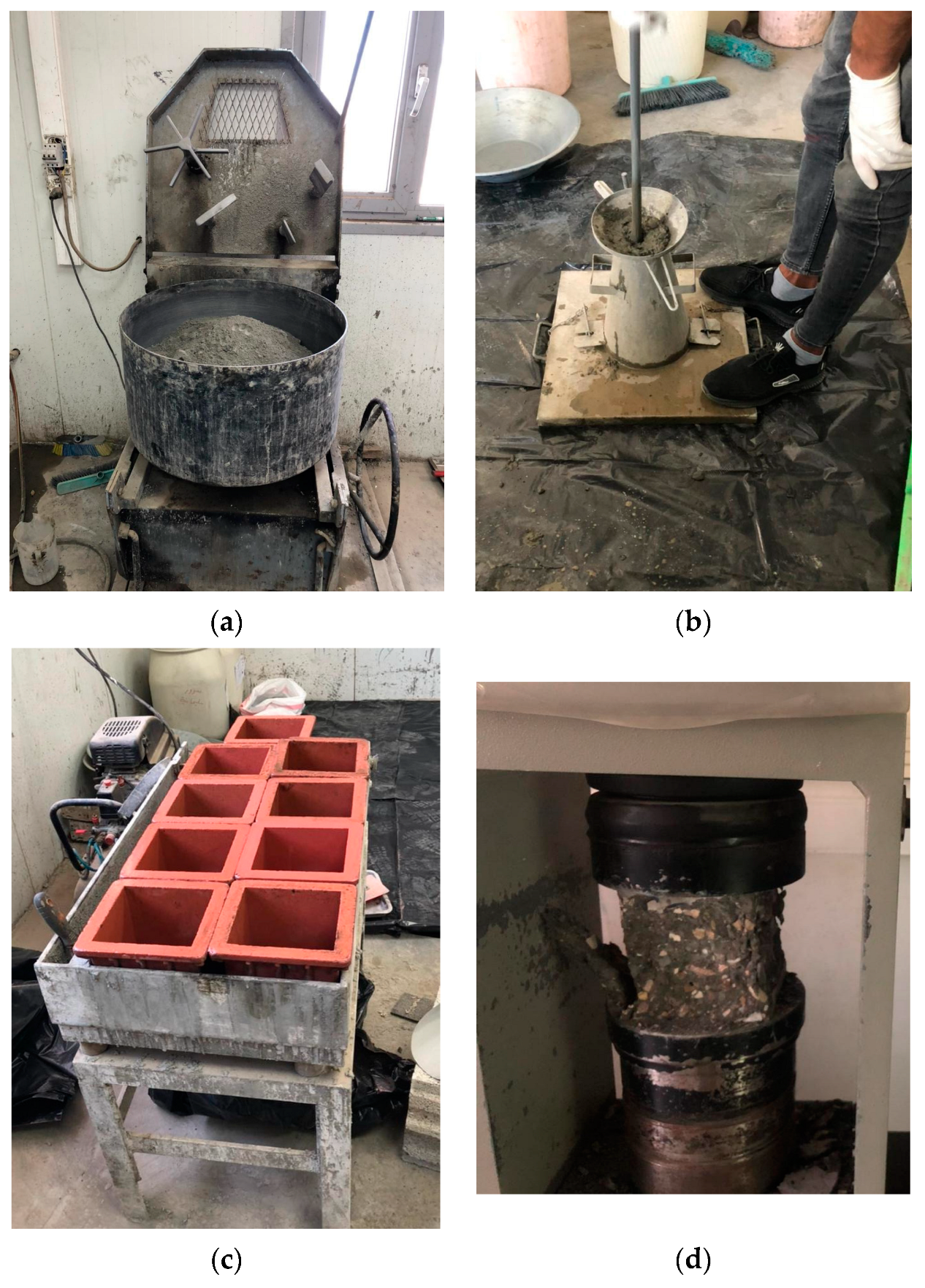
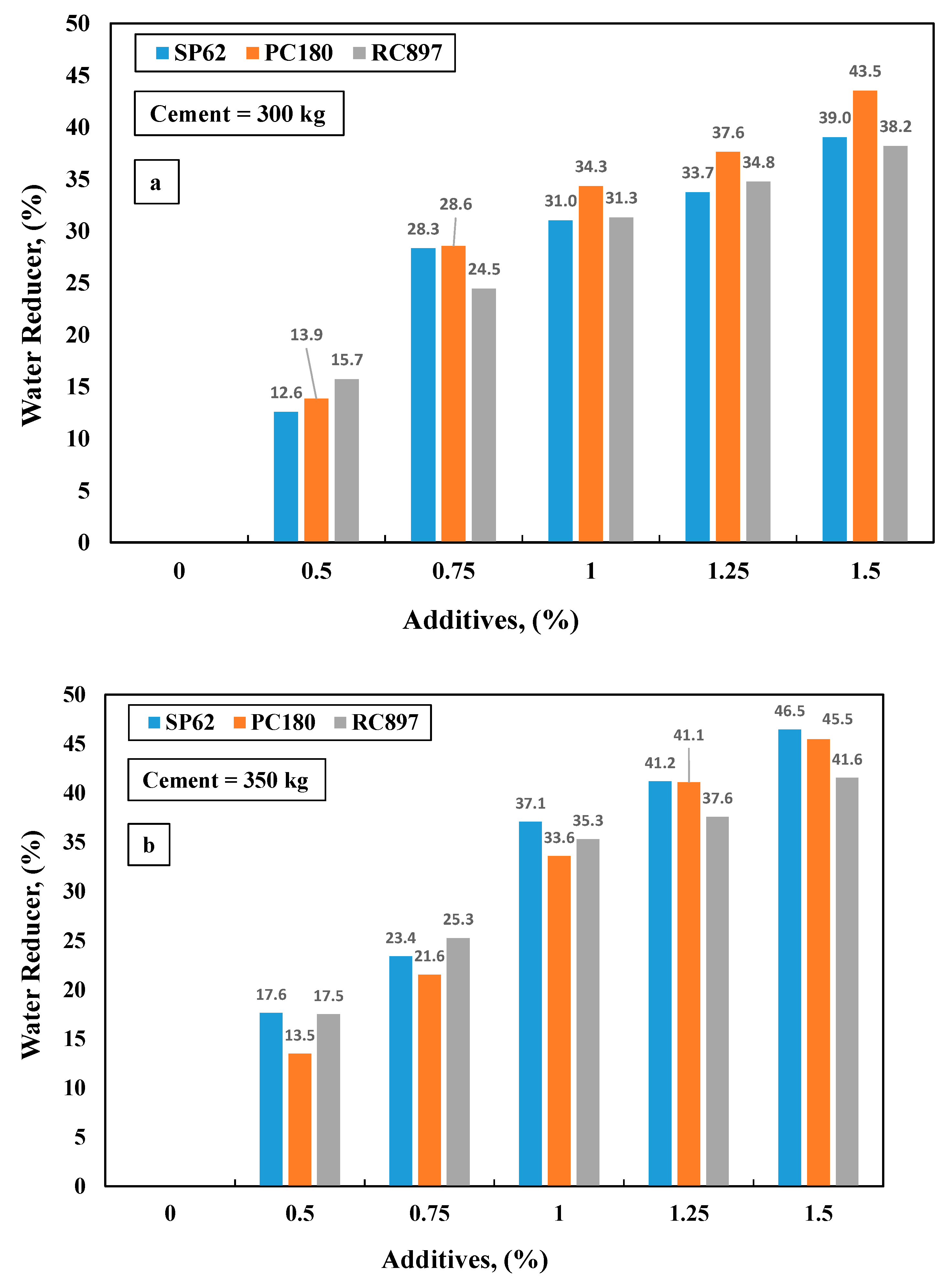

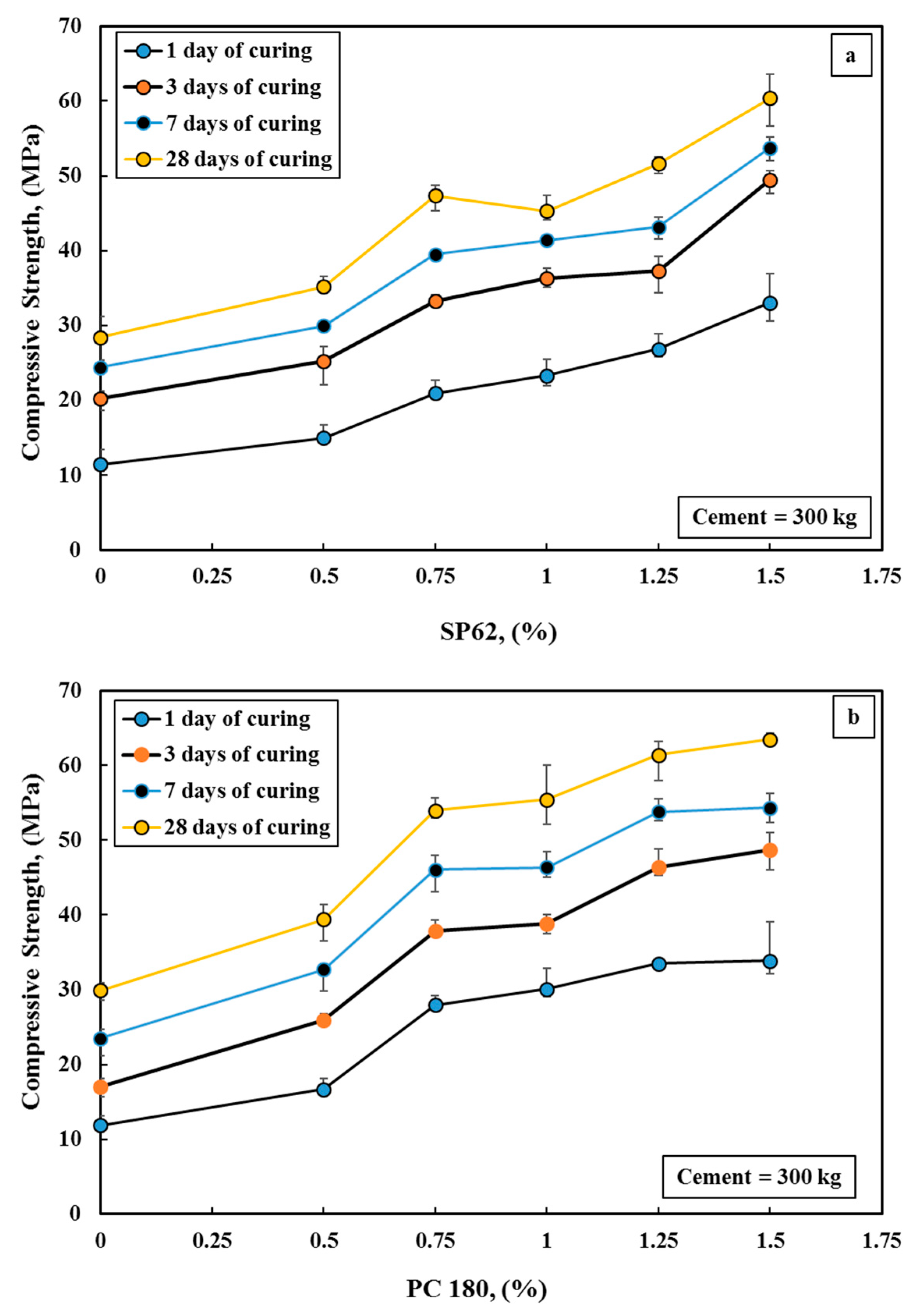

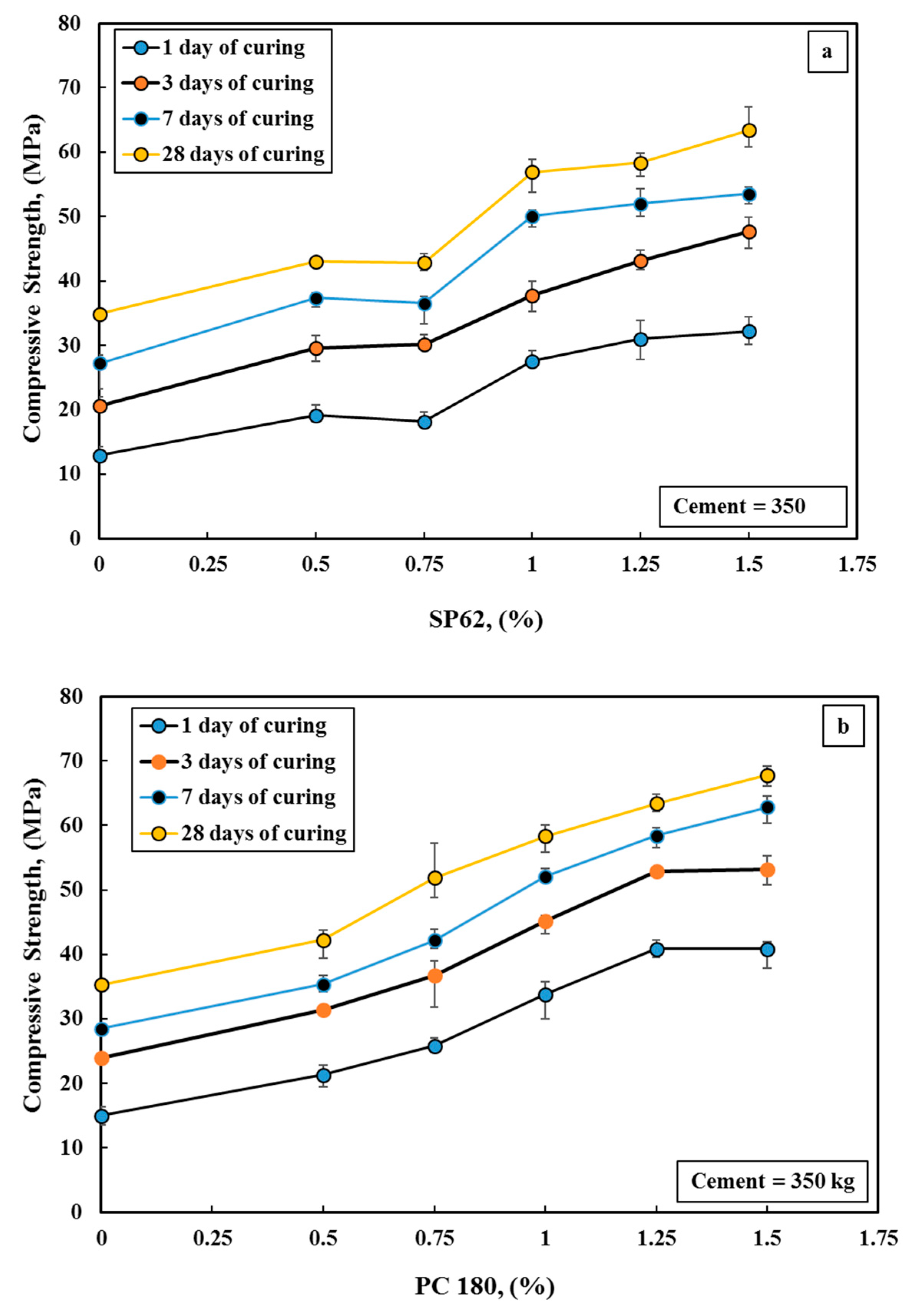
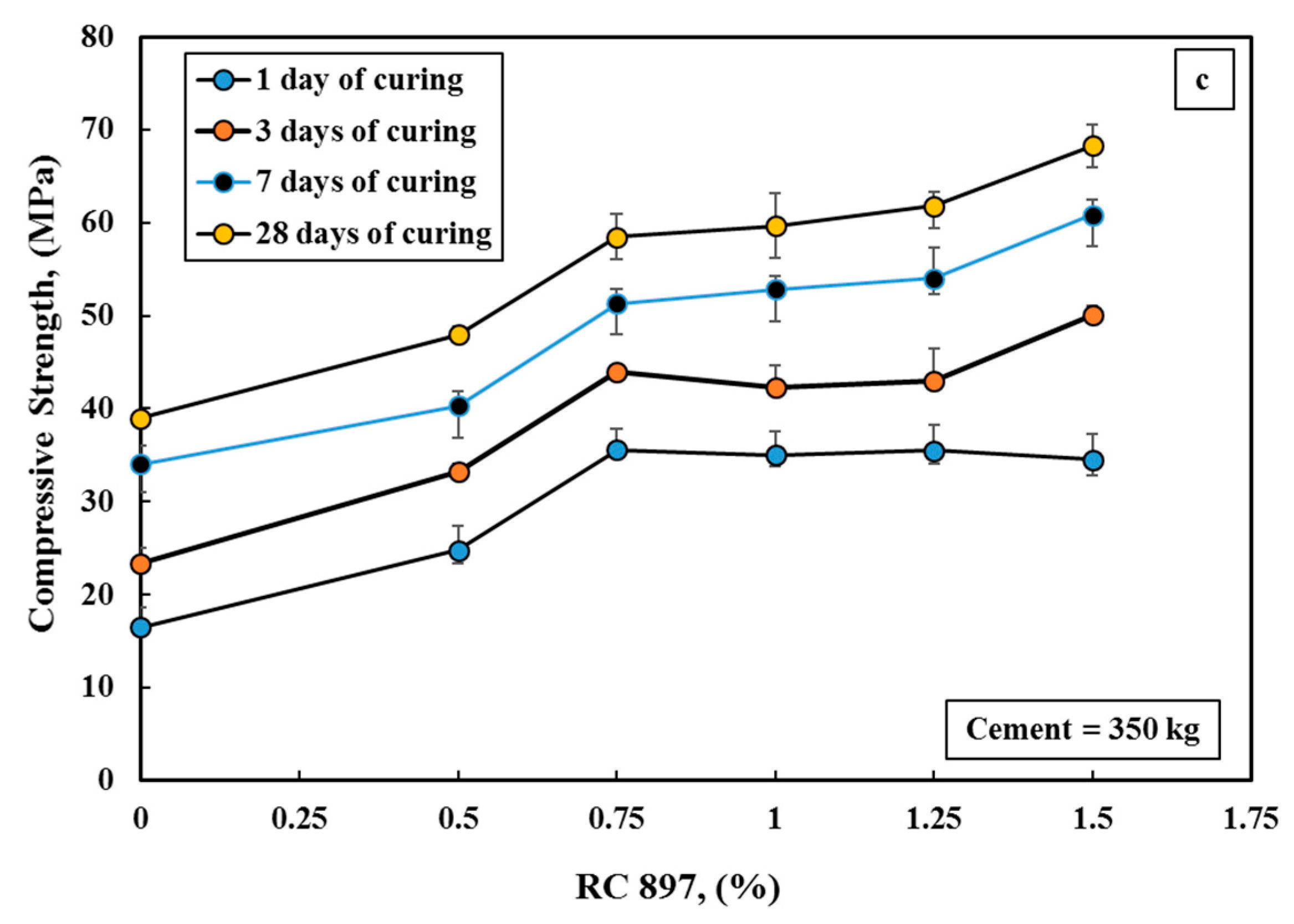
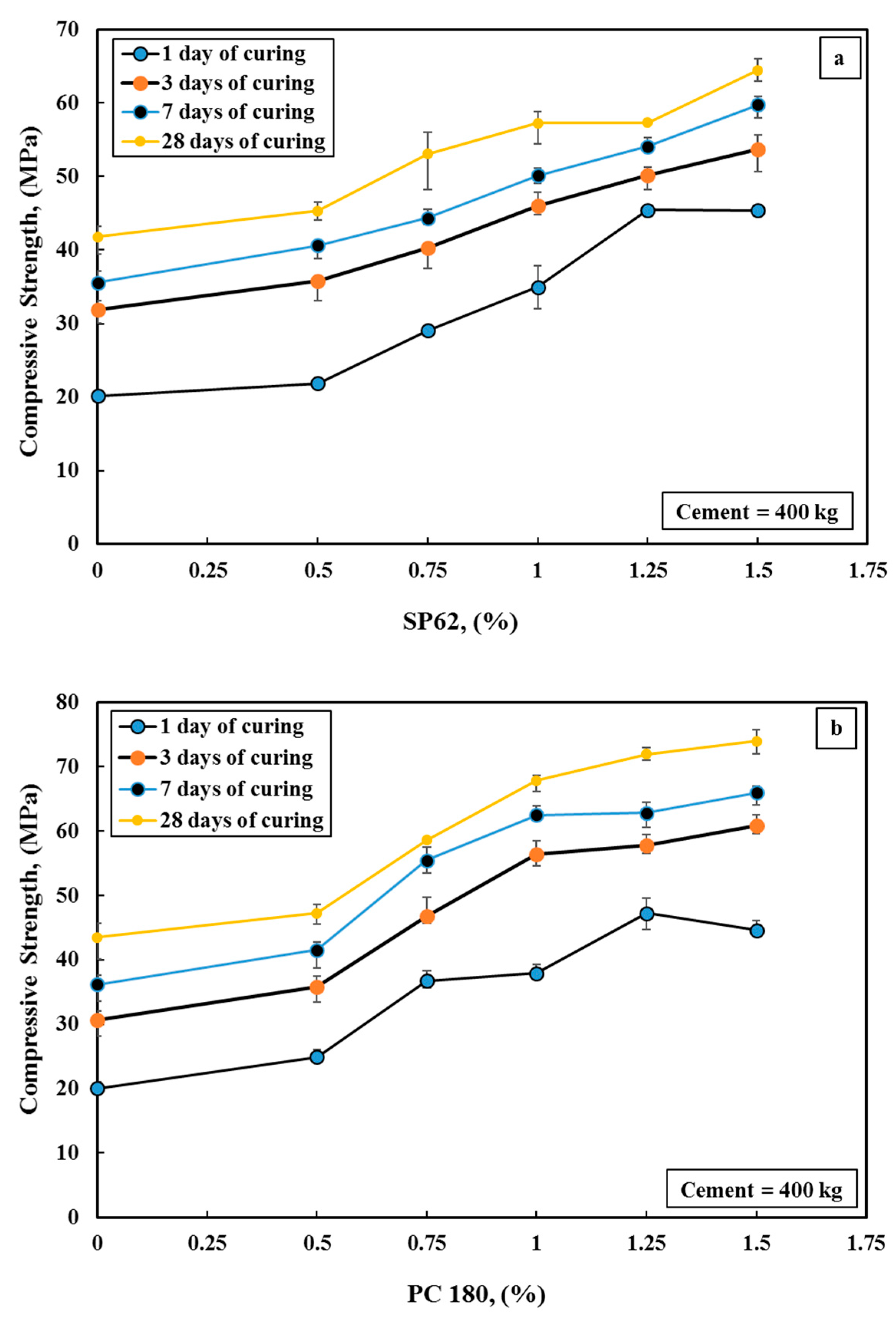

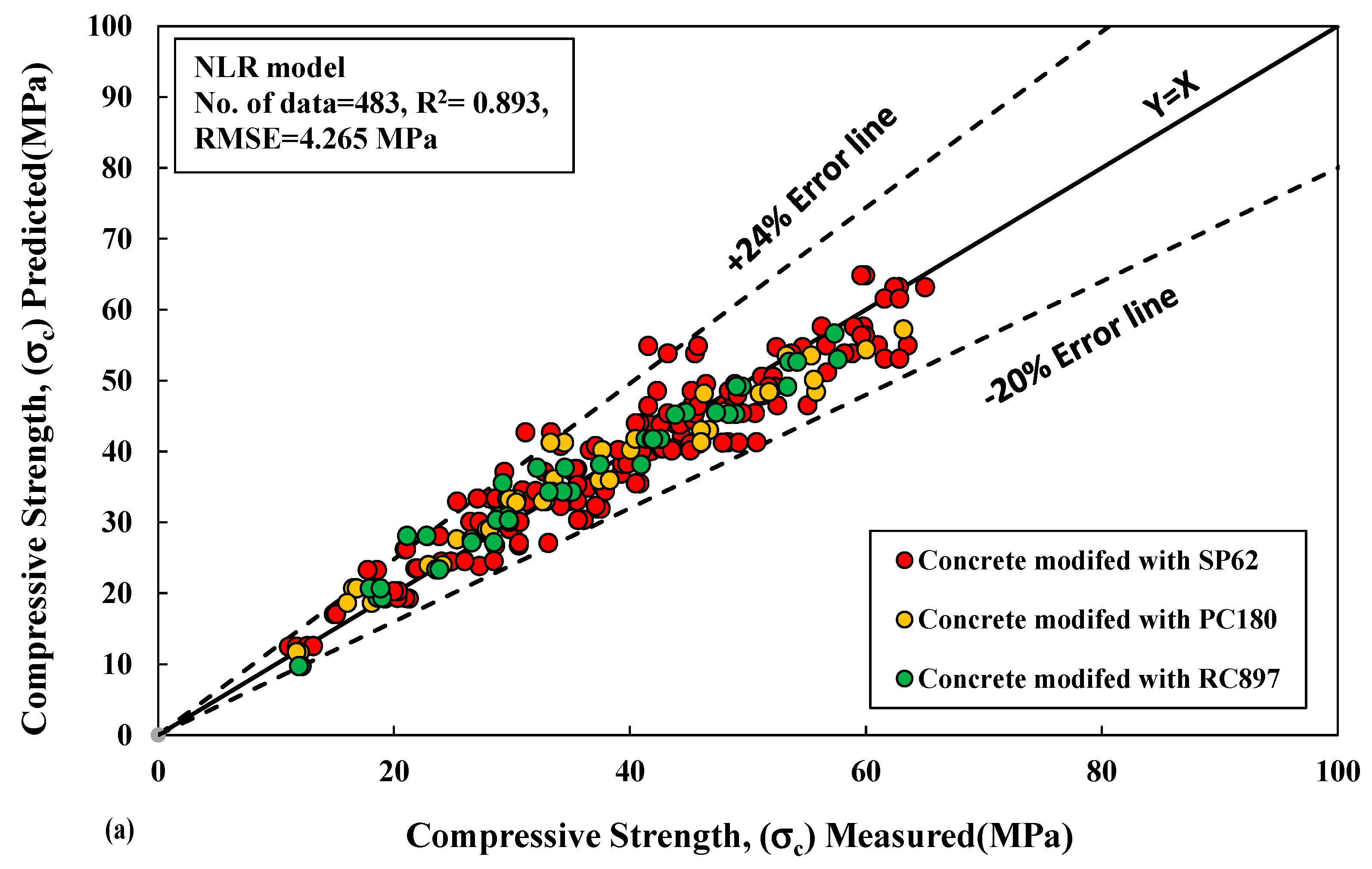
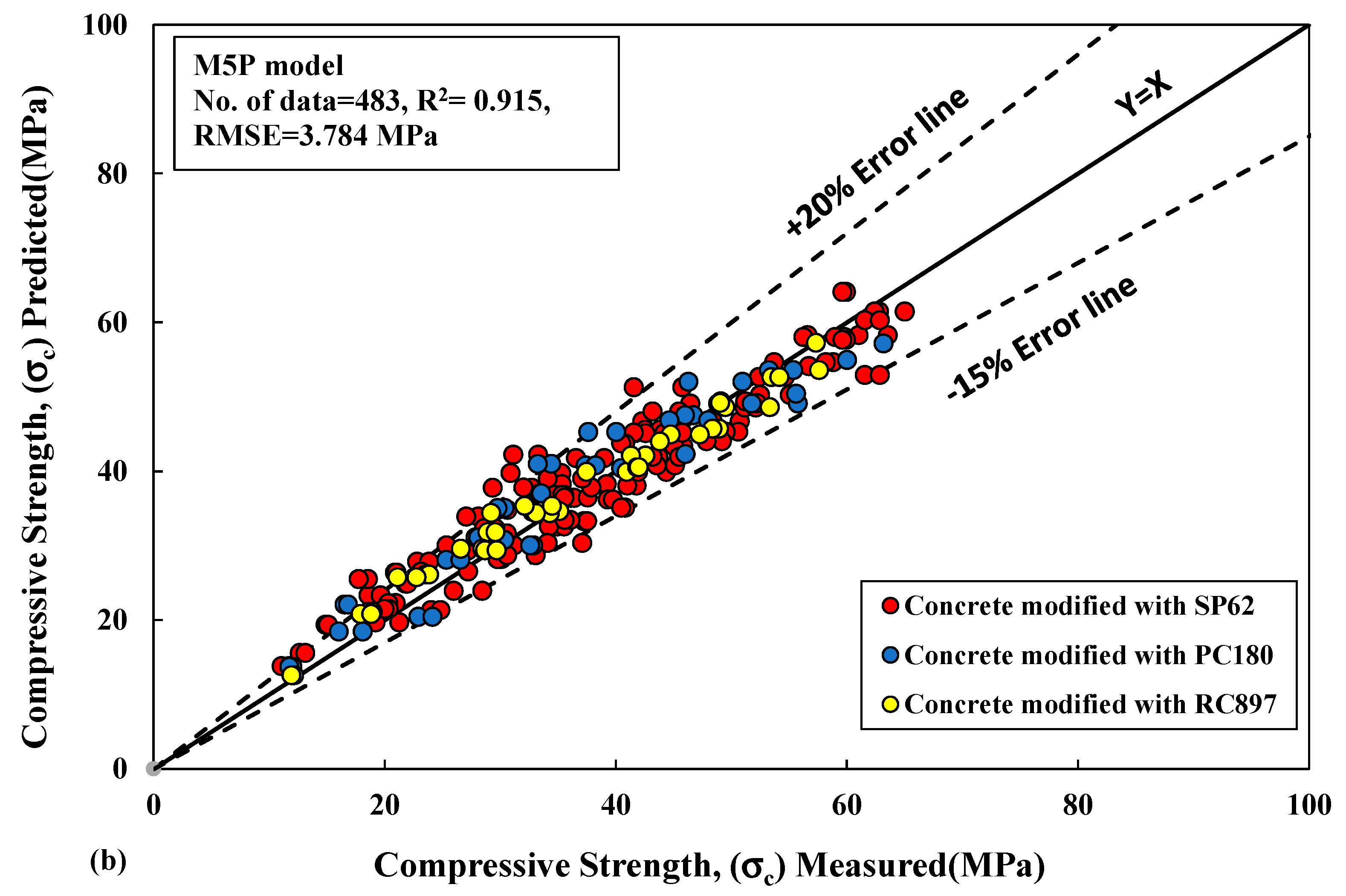
| Chemical composition | CaO | 63.9% |
| SiO2 | 20.1% | |
| Al2O3 | 4.08% | |
| Fe2O3 | 5.10% | |
| MgO | 1.48% | |
| SO3 | 2.20% | |
| LOI | 3.41% | |
| Mineralogical composition | Ca3SiO5 | 66.3% |
| Ca2SiO4 | 7.67% | |
| Ca3Al2O6 | 2.19% | |
| Ca4Al2Fe2O10 | 15.5% |
| Additives | SP62 | RC897 | PC180 |
|---|---|---|---|
| Color | Brown | Light yellow | Amber |
| State | Liquid | Liquid | Liquid |
| Density, (gm/cm3) | 1.1 | 1.08 ± 0.02 | 1.07 ± 0.02 |
| pH | - | 4.5 ± 1.0 | 5 ± 1 |
| Chloride content | 0.1% | <0.10 mass-% | <0.10 mass.-% |
| Alkali content (Na2O equivalent) | <8.5 mass-% | <8.5 mass-% | <8.5 mass-% |
| Materials | Mix 1 | Mix 2 | Mix 3 |
|---|---|---|---|
| Cement, kg | 300 | 350 | 400 |
| Coarse aggregate, kg | 788 | 669 | 557 |
| Crushed stone, kg | 98 | 96 | 186 |
| Sand, kg | 1083 | 1145 | 1115 |
| Water, kg | 195.73 | 221 | 225.3 |
| Slump Retention, mm | |||||||
|---|---|---|---|---|---|---|---|
| Cement, kg | Additive, % | SP62 | PC180 | RC897 | |||
| 10 min. | 30 min. | 10 min. | 30 min. | 10 min. | 30 min. | ||
| 300 | 0 | 210 | 208 | 200 | 190 | 210 | 210 |
| 0.5 | 200 | 80 | 200 | 80 | 200 | 60 | |
| 0.75 | 210 | 100 | 210 | 90 | 210 | 80 | |
| 1 | 200 | 85 | 200 | 80 | 210 | 80 | |
| 1.25 | 200 | 120 | 215 | 100 | 210 | 90 | |
| 1.5 | 200 | 90 | 210 | 95 | 210 | 90 | |
| 350 | 0 | 210 | 215 | 210 | 215 | 210 | 215 |
| 0.5 | 200 | 90 | 200 | 90 | 200 | 90 | |
| 0.75 | 200 | 0 | 200 | 100 | 210 | 100 | |
| 1 | 220 | 90 | 210 | 110 | 200 | 90 | |
| 1.25 | 210 | 130 | 210 | 80 | 200 | 100 | |
| 1.5 | 200 | 100 | 220 | 130 | 210 | 110 | |
| 400 | 0 | 200 | 100 | 200 | 100 | 200 | 100 |
| 0.5 | 210 | 80 | 200 | 80 | 210 | 70 | |
| 0.75 | 205 | 90 | 210 | 90 | 220 | 90 | |
| 1 | 220 | 100 | 210 | 120 | 210 | 100 | |
| 1.25 | 210 | 110 | 210 | 50 | 210 | 115 | |
| 1.5 | 200 | 90 | 215 | 70 | 220 | 80 | |
| Additive | |||
|---|---|---|---|
| Model Parameter | SP62 | RC897 | PC180 |
| β1 | 52.60 | 282.2 | 303.8 |
| β2 | −0.491 | −0.13 | −0.116 |
| β3 | 652.5 | 298 | 273 |
| β4 | 0.006 | 0.029 | 0.051 |
| β5 | 2.018 | 2.017 | 2.01 |
| β6 | −1.33 | −1.33 | −1.36 |
| β7 | −33.1 | 69.07 | 124.8 |
| β8 | −0.125 | 0.008 | −0.248 |
| β9 | 1.297 | 1.467 | 1.467 |
| β10 | 0.303 | −0.37 | −0.377 |
| β11 | −720 | −712 | −715 |
| β12 | −0.008 | −0.009 | −0.01 |
| β13 | 0.209 | 2.229 | 2.120 |
| β14 | 2.00 | 0.574 | 0.634 |
| R2 | 0.89 | 0.92 | 0.94 |
| RMSE (MPa) | 4.220 | 3.867 | 3.556 |
| Additive | |||||||||||
|---|---|---|---|---|---|---|---|---|---|---|---|
| LM Number | β1 | β2 | β3 | β4 | β5 | β6 | β7 | β8 | R2 | RMSE (MPa) | |
| SP62 | 1 | 78.4 | 0.0051 | 0 | 0 | 0 | 0.3114 | 5.491 | −15.22 | 0.91 | 3.784 |
| 2 | 74.03 | 0.0051 | 0 | 0 | 0 | 0.3114 | 5.491 | −13.45 | |||
| 3 | 51.98 | 0.0051 | 0 | 0 | 0 | 0.3114 | 5.967 | −9.737 | |||
| 4 | 38.08 | 0.0127 | 0 | 0 | 0 | 0.888 | 5.499 | 0.2689 | |||
| 5 | −7.795 | −0.0006 | 0 | 0 | 0 | 0.331 | 3.6161 | 36.01 | |||
| 6 | −7.795 | −0.006 | 0 | 0 | 0 | 0.29 | 3.174 | 36.02 | |||
| 7 | −58.81 | 0.0122 | −0.0153 | 0 | 0 | 0.2877 | 0.4122 | 65.65 | |||
| 8 | −50.1 | 0.0122 | −0.0153 | 0 | 0 | 0.2877 | 0.4122 | 61.94 | |||
| 9 | −61.61 | 0.0122 | 0 | 0 | 0 | 0.2877 | 0.4122 | 49.89 | |||
| 10 | −77.31 | 0.0227 | 0 | 0 | 0 | 0.4121 | 0.4122 | 61.9 | |||
| PC180 | 1 | −77.311 | 0.0227 | 0 | 0 | 0 | 0.4121 | 0.4122 | 61.9 | 0.92 | 4.00 |
| 2 | −98.45 | 0.052 | 0 | 0 | 0 | 0.278 | 0 | 61.51 | |||
| 3 | −112.6 | 0.0261 | 0 | 0 | 0 | 0.3861 | 0 | 84.71 | |||
| 4 | −93.21 | 0.0326 | 0 | 0 | 0 | 0.3681 | 0 | 64.14 | |||
| 5 | −106.8 | 0.0335 | 0 | 0 | 0 | 0.4932 | 0 | 76.37 | |||
| RC897 | 1 | −60.77 | 0 | 0.0374 | 0 | 0 | 2.654 | 1.353 | 9.7022 | 0.96 | 2.846 |
| 2 | −50.87 | 0 | 0.041 | 0 | 0 | 2.654 | 1.125 | 2.481 | |||
| 3 | −49.95 | 0 | 0.0257 | 0 | 0 | 2.654 | 1.584 | 21.82 | |||
| 4 | −60.34 | 0 | 0.0257 | 0 | 0 | 2.654 | 1.743 | 26.2 | |||
| 5 | −73.07 | 0 | 0.0228 | 0 | 0 | 4.13 | 0.8277 | 31.23 | |||
| 6 | −37.81 | 0 | 0.0629 | 0 | 0 | 0.4122 | 3.87 | −20.7 | |||
Disclaimer/Publisher’s Note: The statements, opinions and data contained in all publications are solely those of the individual author(s) and contributor(s) and not of MDPI and/or the editor(s). MDPI and/or the editor(s) disclaim responsibility for any injury to people or property resulting from any ideas, methods, instructions or products referred to in the content. |
© 2023 by the authors. Licensee MDPI, Basel, Switzerland. This article is an open access article distributed under the terms and conditions of the Creative Commons Attribution (CC BY) license (https://creativecommons.org/licenses/by/4.0/).
Share and Cite
Mohammed, A.S.; Emad, W.; Sarwar Qadir, W.; Kurda, R.; Ghafor, K.; Kadhim Faris, R. Modeling the Impact of Liquid Polymers on Concrete Stability in Terms of a Slump and Compressive Strength. Appl. Sci. 2023, 13, 1208. https://doi.org/10.3390/app13021208
Mohammed AS, Emad W, Sarwar Qadir W, Kurda R, Ghafor K, Kadhim Faris R. Modeling the Impact of Liquid Polymers on Concrete Stability in Terms of a Slump and Compressive Strength. Applied Sciences. 2023; 13(2):1208. https://doi.org/10.3390/app13021208
Chicago/Turabian StyleMohammed, Ahmed Salih, Wael Emad, Warzer Sarwar Qadir, Rawaz Kurda, Kawan Ghafor, and Raed Kadhim Faris. 2023. "Modeling the Impact of Liquid Polymers on Concrete Stability in Terms of a Slump and Compressive Strength" Applied Sciences 13, no. 2: 1208. https://doi.org/10.3390/app13021208
APA StyleMohammed, A. S., Emad, W., Sarwar Qadir, W., Kurda, R., Ghafor, K., & Kadhim Faris, R. (2023). Modeling the Impact of Liquid Polymers on Concrete Stability in Terms of a Slump and Compressive Strength. Applied Sciences, 13(2), 1208. https://doi.org/10.3390/app13021208








